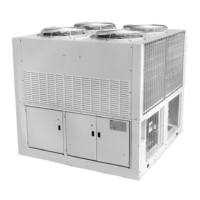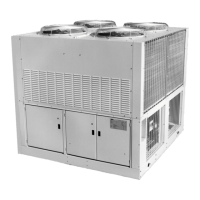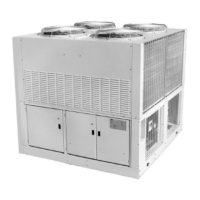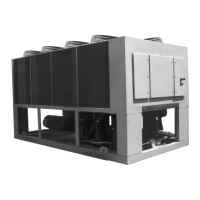44
AGR 070A through 100A Product Manual AGR-3
4.
Liquid line solenoid valves should be located adjacent to the expansion valve with possibly only a
sight glass interposing the two.
In the event that situations 2 or 3 above are possible, the application should include a check valve at the
condenser end of the liquid line. The check valve should be a low pressure drop valve, and since the
line between the check valve and the solenoid valve can be comparable to a pressure vessel as the line
becomes heated, the check valve should include a pressure relief device, relieving from the line side to
the condenser side of the circuit. The relief can be sized for a pressure differential from 80 to 180 psi,
but not more than 180 psi, and should be auto-resetting as the pressure is relieved.
CAUTION
: The liquid line should not include a check valve unless the line also includes an automatic
resetting pressure relief device.
CAUTION
: If the relief device being used is relieving from the line to the condenser side of the check
valve, the maximum desirable pressure differential with R-22 refrigerant is 180 psi, with R-134a, 100
psi.
If liquid lines are short, they may be of smaller diameter than the size indicated in the ASHRAE
Refrigerant Handbook, 1998 Edition, Chapter 2, Tables 3 or 4. As indicated above, the designer must
size the liquid line to assure that pure liquid will reach the inlet of the expansion valve. If the condenser
is sized to produce 10ºF of subcooling, and each degree represents 3.0 psi with R-22 (or 2.2. psi with R-
134a). The liquid line and its refrigerant specialties may have pressure losses totaling 10 x 3.05 psi (or
10 x 2.2) and still satisfy the objective of delivering pure liquid to the expansion valve.
In calculating the pressure losses, or gains, note that each foot of rise in a liquid line results in an
approximate 0.5 psi loss. Thus a 10 foot rise represents 5 pounds per square inch loss in refrigerant
pressure, or the equivalent of 1.6ºF subcooling with R-22. Total line losses will include values for line
friction, equivalents for valves and elbows and pressure losses from manufacturers’ catalogs for driers,
solenoids, sight glasses, etc.
In estimating condenser subcooling, note that saturated condensing pressure should be read, or
estimated, at the same point in the system where the liquid refrigerant temperature is obtained. That
condensing pressure is not the discharge pressure read at the compressor outlet. Because it is less, the
net value of subcooling will be lower than might otherwise be assumed.
Where rises in liquid lines result in a 0.5 PSI loss per foot of lift, a drop in the liquid line results in a
rise in the refrigerant pressure. A substantial drop in the liquid line can assist the delivery of pure liquid
at the valve. If it is a substantial increase because of a large drop, the expansion valve selection must be
re-checked to confirm that the valve to be used is not radically oversized.
Liquid Lines from Condensers to Receivers
Receivers in a refrigerant system have both liquid and gas contained within the same vessel. In air-
cooled condenser applications, the condensing temperature can change rapidly resulting in the
requirement for more liquid at a lower temperature and pressure to be introduced into the receiver.
In order for this flow of lower temperature and pressure of liquid refrigerant to enter the receiver, 1) the
receiver must be located below the condenser outlet with no restrictions in the line, and 2) the liquid
line connecting the condenser and the receiver must be sized for a maximum velocity of 100 fpm.
Piping sizes for this are shown in the ASHRAE tables.
Note
: If the interconnecting piping described above contains a Seasontrol back-flooding type head
pressure control valve representing a restriction in the liquid line, a separate vent from the top of the
receiver to the discharge line entering the condenser is required.

